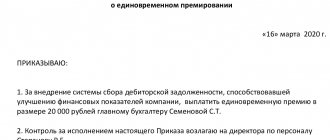Pay taxes in a few clicks!
Pay taxes, fees and submit reports without leaving your home!
The service will remind you of all reports. Try for free
Employees are given bonuses as incentives for quality work and length of service. It can be paid annually, monthly or quarterly. The employer decides how often to stimulate employees. Taxes are collected on employee salaries, and many people wonder if bonuses are taxable.
A little theory: accounting concepts and types of bonuses
The bonus is an optional payment. This is a monetary reward for an employee for special merits. There are several types of incentives:
- by form of payment: in cash or in the form of a gift;
- by frequency of payments: one-time or for a certain period;
- by appointment: for performing special tasks;
- according to the indicator: for the anniversary, for length of service.
According to Article 191 of the Labor Code of the Russian Federation, bonuses can be awarded for:
- high qualifications;
- high labor achievements;
- active in the development of the company.
How to make a bonus payment
Formalize a one-time incentive with an order for the payment of a one-time bonus. The order can be drawn up in free form or you can use the standardized forms T-11 to encourage one employee or T-11A to encourage a group. In your order please indicate:
- Full name, position and department of the employee being awarded;
- the reason for the promotion;
- type - in our case, premium;
- amount - in numbers and words.
The employee must read the order and sign it.
Conditions for awarding bonuses
There are several official conditions for bonuses for employees:
- Federal Law No. 208. If one of the founders of the organization decides to award a bonus to employees, he makes this decision together with his colleagues.
- Article 129 of the Labor Code of the Russian Federation. The procedure for calculating monetary remuneration must be specified in the employment contract.
- Article 135 of the Labor Code of the Russian Federation. All issues of bonuses for employees must be agreed with the trade union, if there is one at the enterprise
Add bonuses for free and automatically calculate taxes through Kontur.AccountingTry for free
The legislative framework
Article 129 (Part 1) of the Labor Code of the Russian Federation states that the bonus, including the monthly one, is part of the employee’s remuneration, a payment that stimulates and encourages work. The bonus, however, is not a mandatory payment, i.e. the employer has no obligation to pay it to members of the workforce. However, this does not mean that the administration can arbitrarily issue monthly bonuses and deprive them of these payments.
If a bonus is mentioned in a collective agreement, in an employment agreement, in the LNA (for example, “Regulations on bonuses”) as obligatory for payment every month, the administration is obliged to accrue and pay it.
It is noteworthy that the Ministry of Labor considers it possible to establish a basic salary less than the minimum wage if the incentive payment in the amount of the basic salary is not lower than the minimum wage for the month (letter No. 14-O/10/B-4085 dated 5/06/18).
From the analysis of legislation it follows that the monthly bonus, if it is enshrined in the internal regulations of the company, must be paid without fail, just like wages. An exception may be a gross violation of labor discipline by an employee, but such an offense must be documented. Otherwise, the employee has grounds to go to court regarding the violation of his rights. In addition, some judges believe that the payment of bonuses can be equated to indexation of wages (determined by the Supreme Court of the Russian Federation No. 18-КГ17-10 of 04/24/17). Ignoring the indexation of wages for the employer is risky - this is a violation of Art. 134 Labor Code of the Russian Federation.
If in the LNA the monthly bonus is not mentioned as part of the mandatory wage system, but is linked by the wording of the document directly to economic indicators, it may not be paid. The reason may be ineffective work of the team.
How are monthly bonuses taken into account when calculating average earnings ?
Payment of a monthly bonus or deprivation of individual employees (the entire team) of the specified payment may therefore depend on:
- wording of the LNA, collective agreement, employment contract;
- company performance indicators;
- performance indicators of an individual employee.
In practice, most often the monthly bonus is established as part of labor payments and is issued regularly. It is taken into account, among other things, when issuing severance pay. Introducing into the LNA a provision on depriving an employee who quit of his own free will of a monthly bonus is illegal: it worsens the citizen’s position compared to other similar employees (definition No. 33-1945/2018 dated 02/20/18 Nizhny Novgorod Regional Court).
On a note! The monthly bonus may be greater than the basic salary (salary). This does not contradict current legislation.
Taxation procedure for bonuses
Employers ask whether the bonus is subject to personal income tax. Their doubts are justified: firstly, such remuneration is always the employee’s income, and the income is taxed; secondly, the bonus is not remuneration.
The answer to this question lies in the first point: the premium is income. According to Article 209 of the Tax Code of the Russian Federation, personal income tax and insurance payments are paid from it. Income tax on remuneration is calculated as standard. Awards received for high achievements in scientific activities, employee rewards in honor of a holiday, and monetary rewards not exceeding 4,000 rubles are exempt from personal income tax.
Annual bonuses. Create a reserve
This article discusses the issue of reserve expenses for annual remuneration, as well as the accounting and tax aspects of this operation.
Reserve for annual remuneration. Peculiarities
Annual bonuses are usually paid in a lump sum. Obviously, the expense in this regard is very significant. At the same time, it is possible to write off the amounts of lump sum payments: create special reserves in tax accounting.
This is very beneficial, since the formation of a reserve allows you to optimize the tax burden. If a reserve is not created, then remunerations accrued at the beginning of the year following the reporting year are taken into account for profit tax purposes in the accrual period (see, for example, letter of the Ministry of Finance of Russia dated October 19, 2015 No. 03-03-06/59642).
Example 1 At the beginning of 2021, remuneration based on the results of 2021 was accrued and paid. This amount will reduce the income tax base for 2021 only. If there is a reserve formed in 2021, the costs of its formation would be included in the tax base for 2021.
It is clear that the decision to create a reserve must be enshrined in the accounting policies. In addition, the accounting policy should include (clause 1 of Article 324.1 of the Tax Code of the Russian Federation):
- reservation method;
- maximum annual contribution amount;
- monthly percentage of contributions to the reserve.
Deductions for payment for length of service and based on the results of work for the year are formed in the same way (clause 6 of Article 324.1 of the Tax Code of the Russian Federation). True, the reserve for paying bonuses for long service has its own peculiarities and, as a rule, raises more questions.
How to calculate monthly interest
You must determine whether the costs of creating a reserve for future expenses are direct or indirect costs. This applies to both “production workers” (workers involved in the production process) and other personnel not directly related to the production process. The main thing is that the chosen method is enshrined in the tax accounting policy (letter of the Ministry of Finance of Russia dated September 16, 2013 No. 03-03-06/1/38134).
The percentage of deductions can be calculated separately for each structural unit, but the reserve is formed for the organization as a whole (letter of the Ministry of Finance of Russia dated December 7, 2012 No. 03-03-06/1/632).
To determine the monthly percentage of contributions to the reserve, an estimate is drawn up in a free form. It should reflect the calculation of the monthly amounts in the reserve in accordance with the data on expected annual expenses.
The calculation includes only economically justified and confirmed data (regulations on wages, collective agreement, staffing table, vacation schedule, etc.) (clause 1 of article 324.1 of the Tax Code of the Russian Federation, clause 1 of article 252 of the Tax Code of the Russian Federation, letter from the Ministry of Finance Russia dated October 25, 2016 No. 03-03-06/2/62147).
The formula for calculating the monthly percentage of contributions to the reserve for future payments:
| Monthly percentage of deductions to the reserve for upcoming payments | = | Supposed payment amount for the coming year, taking into account insurance premiums | : | The estimated amount of labor costs for the coming year, taking into account insurance contributions (“pension”, VNIM, “medical”, against industrial accidents and occupational diseases). | X | 100% |
We form a reserve throughout the year
To formulate, the amount of actual labor costs for the month, taking into account insurance premiums, is multiplied monthly by the percentage of contributions to the reserve. The result will be taken into account for tax purposes (clause 24 of article 255 of the Tax Code of the Russian Federation).
Deductions to the reserve are made at the end of each month and are included in the labor costs of the relevant categories of employees (clause 24 of article 255 of the Tax Code of the Russian Federation, clause 2 of article 324.1 of the Tax Code of the Russian Federation).
The amount of the reserve accumulated on an accrual basis since the beginning of the year should not exceed the maximum amount established in the accounting policy.
Example 2 According to the 2017 tax accounting policy, in 2021 expenses were:
— 12,000,000 rub. - for wages;
— 1,500,000 rub. - payment of remuneration based on the results of work for the year.
In 2021, the rates of insurance contributions from the wage fund are 22% (in the Pension Fund), 2.9% (in the Social Insurance Fund), 5.1% (in the Federal Compulsory Medical Insurance Fund).
The company's activities belong to the ninth class of professional risk, the rate of contributions for compulsory accident insurance is 1%.
In total, the total insurance premium rate will be 31% (22 + 2.9 + 5.1 + 1).
We calculate the monthly percentage of contributions to the reserve for upcoming expenses for the payment of remunerations at the end of the year.
The estimated annual amount for the payment of annual remuneration, taking into account insurance premiums, will be: RUB 1,965,000. (RUB 1,500,000 + RUB 1,500,000 x 31%).
Based on this calculation, the maximum amount of contributions to the reserve will be 1,965,000 rubles.
The estimated annual wage fund, taking into account insurance contributions, is equal to: RUB 15,720,000. (RUB 12,000,000 + RUB 12,000,000 x 31%).
We receive a monthly percentage of contributions for 2021 in the manner prescribed by law: 12.5%. RUB 1,965,000 : RUB 15,720,000 x 100% =
Based on these calculations, the taxpayer compiled an estimate of monthly contributions to the reserve in 2021:
| Month | Actual labor costs, rub. | Insurance premiums, rub. (gr. 2 x 31%) | Amount of contributions to the reserve, rub. (gr. 2 + gr. 3) x 12.5%) | Reserve amount at the end of the month, rub. |
| 1 | 2 | 3 | 4 | 5 |
| January | 1 000 000 | 310 000 | 163 750 | 163 750 |
| February | 1 000 000 | 310 000 | 163 750 | 327 500 |
| March | 1 000 000 | 310 000 | 163 750 | 491 250 |
| April | 1 000 000 | 310 000 | 163 750 | 655 000 |
| May | 1 000 000 | 310 000 | 163 750 | 818 750 |
| June | 1 000 000 | 310 000 | 163 750 | 982 500 |
| July | 1 000 000 | 310 000 | 163 750 | 1 146 250 |
| August | 1 000 000 | 310 000 | 163 750 | 1 310 000 |
| September | 1 000 000 | 310 000 | 163 750 | 1 473 750 |
| October | 1 100 000 | 341 000 | 180 125 | 1 653 875 |
| November | 1 100 000 | 341 000 | 180 125 | 1 834 000 |
| December | 1 100 000 | 341 000 | 131 000 | 1 965 000 |
| Total | 12 300 000 | 3 813 000 | 1 965 000 | 1 473 750 |
The amount of the reserve accumulated on an accrual basis since the beginning of the year should not exceed the maximum amount established in the accounting policy in the amount of RUB 1,965,000.
In this case, if contributions to the reserve in January-November amounted to 1,834,000 rubles, then in December their value will be equal to: 131,000 rubles. (1,965,000 - 1,834,000).
In tax accounting, the date of recognition of expenses in the form of contributions to the reserve is the date of accrual of the reserve, and not the date of payment of remuneration from the funds of the created reserve (subclause 2, clause 7, article 272 of the Tax Code of the Russian Federation).
Thus, by directing monthly contributions to the reserve, the organization reduces the income tax base during the period of creating the reserve for these contributions.
What to do with the remaining reserve?
It is possible that there may be a difference between the accrued reserve and the actual accrued benefits. underutilized reserve for annual bonus payment.
At the end of the year, as of December 31, it is necessary to conduct an inventory of the reserve in order to identify the amount of underutilization of the reserve or its overexpenditure and adjust the taxable base.
For example, during 2021, contributions were made to the reserve, and remunerations for the year will be paid after these same results are summed up. For example, in March 2018.
In this case, it is necessary to clarify the reserve for the payment of remuneration based on the results of work for the year at the end of the tax period (clause 4 of Article 324.1 of the Tax Code of the Russian Federation, letter of the Ministry of Finance of Russia dated 04/05/13 No. 03-03-06/2/11148). Attention: this clarification procedure is defined only for reserves for vacation pay.
With regard to the reserve for the payment of remuneration based on the results of work for the year, it is necessary to establish in the accounting policy a reasonable criterion by which, on the last date of the tax period, the amount of the balance of the reserve that will be carried over to the next tax period will be clarified. For example, a percentage of profit or an amount per employee, etc.
Consequently, if the enterprise continues to create a reserve for the upcoming payment of remuneration based on the results of work for the year and next year, the unused balance may not be included in non-operating income and will be taken into account when forming a reserve for the payment of remuneration based on the results of work for the next year.
Example 3 Let's use the data from example 2. The amount of the reserve for 2021 was 1,965,000 rubles. and will be expensed on your 2021 income tax return.
In January 2021, employee benefits were accrued in the amount of RUB 1,900,000. The difference between the amount of the accrued reserve and the amount of accrued remuneration is RUB 65,000.
If in 2021 the organization continues to create a reserve for the upcoming payment, this difference will be taken into account when creating it.
There is no need to reflect it in non-operating income for 2021.
If no reserve for remuneration is created in 2021, the difference is reflected in non-operating income in the 2021 declaration.
The courts also support this approach.
Thus, the tax authorities considered that the company unlawfully did not include in non-operating income when calculating income tax the amount of the reserve for the payment of remuneration at the end of the year, accrued but not fully spent in 2013. Awards from this reserve were made on February 20, 2014.
Tax officials referred to the accounting policy for 2013: it stipulated the need to include reserves unused at the end of the tax period in non-operating income.
However, the court sided with the taxpayer, pointing out that the Federal Tax Service had no reason to consider the disputed amount an “unused reserve.” The unspent balance of the reserve is included for tax purposes in non-operating income of the current tax period if the taxpayer considers it inappropriate to form a reserve of upcoming expenses for vacations and remuneration for the next tax period (Article 324.1 of the Tax Code of the Russian Federation). If the organization has not changed its accounting policy regarding the creation of the reserve, then the balance can be carried forward to the next tax period.
The court declared illegal the decision of the Federal Tax Service on the assessment of additional taxes and penalties, the application of tax sanctions, and the reduction of income tax losses for 2012 (resolution of the Arbitration Court of the Central District dated 06.06.17 No. A35-220/2016).
A similar approach to the balance of the underutilized reserve for the payment of remuneration is shared by the Ministry of Finance (see, for example, letters dated 03/20/09 No. 03-03-06/4/19, dated 12/14/07 No. 03-03-06/2/227) .
If the amount of rewards exceeds the formed reserve
If the amount of actually accrued remuneration based on the results of work for 2021 exceeds the amount of the reserve, the excess should be taken into account when calculating the income tax base for 2021 in labor costs as of December 31, 2021.
What if, at the end of the year, benefits are accrued in an amount greater than the amount of the reserve, and the accrual of remuneration is made after filing the annual tax return?
If the funds of the actually accrued reserve, confirmed by the inventory on the last day of the tax period, are insufficient, the taxpayer is obliged, as of December 31 of the year in which the reserve was accrued, to include in expenses the amount of actual expenses for the payment of remuneration and, accordingly, the amount of insurance contributions for which previously the specified reserve was not created (clause 3 of Article 324.1 of the Tax Code of the Russian Federation).
According to the explanations of the Ministry of Finance, the taxpayer has the right to recalculate the tax base and the amount of tax for the tax period in which distortions relating to the previous tax period were identified, in the case where the distortions led to excessive payment of tax (paragraph 3, paragraph 1, article 54 of the Tax Code RF) (letter of the Ministry of Finance of Russia dated 04/02/12 No. 03-03-06/4/25).
Therefore, if:
- the amount of the reserve formed in 2021 for the payment of remuneration based on the results of work for this year will be insufficient and
- if the remuneration is accrued and paid in 2018,
then the positive difference between the actually accrued amount of remuneration and the amount of the formed reserve can be taken into account in labor costs for 2021 without submitting an updated tax return for 2021.
Still, it is safer to provide a “clarification”, since the expense in this case should be recognized on December 31 of the year in which the benefits were accrued.
Example 4 Let's use the data from example 2. The amount of the reserve formed for 2021 is 1,965,000 rubles. In March 2018, employee benefits were accrued based on the results of work for 2017, along with insurance contributions in the amount of RUB 2,200,000.
The difference between the amount of the accrued reserve and the amount of accrued remuneration is: RUB 235,000. (2,200,000 - 1,965,000).
If the accrual of remuneration was made before the submission of the annual declaration, the difference will be reflected in expenses on December 31, 2021, if after the submission of the annual declaration, then an updated declaration must be submitted.
If a reserve is not created in tax accounting, then in such cases it is necessary to apply Accounting Regulation 18/02 “Accounting for calculations of corporate income tax” (approved by order of the Ministry of Finance of Russia dated November 19, 2002 No. 114n) as part of measures to reform accounting in compliance with international financial reporting standards.
Provided that funds for the payment of annual remunerations for length of service are transferred to the reserve on a monthly basis, and in tax accounting, expenses for remunerations during the periods of their payment in December are recognized as labor costs, the procedure for applying PBU 18/02 will be as follows. The resulting monthly (from January to November) difference between the amounts of expenses can be qualified as a deductible temporary difference (subclauses 8 - 11 of the document).
The deductible temporary difference for the reporting period is reflected separately in the analytical accounting of assets and liabilities in the assessment of which it arose (clause 13 of PBU 18/02).
This deductible temporary difference results in a deferred tax asset. The latter is reflected in debit 09 “Deferred tax assets” in correspondence with credit 68 “Calculations for taxes and fees” (subclause 14, 17 PBU 18/02, Instructions for using the Chart of Accounts).
Deferred tax assets are settled when the deductible temporary differences are fully settled, in this case in December. Amounts by which deferred tax assets are reduced or fully repaid in the current reporting period are reflected in the accounting records as a credit to account 09 in correspondence with the debit of account 68 (paragraph 2 of clause 17 of PBU 18/02, Instructions for using the Chart of Accounts).
Personal income tax
Remuneration due to employees is recognized as subject to personal income tax (subclause 6, clause 1, article 208, clause 1, article 209 of the Tax Code of the Russian Federation).
The organization as a tax agent is obliged to withhold the accrued amount of personal income tax directly from the taxpayer’s income upon their actual payment.
Withholding of the accrued amount of personal income tax is carried out by the tax agent at the expense of any funds paid by him to the taxpayer, when the agent actually pays these funds to the taxpayer himself or to third parties on behalf of the latter (clause 4 of Article 226 of the Tax Code of the Russian Federation).
The withheld amount of personal income tax is reflected in the accounting records as debit 70 in correspondence with credit 68 “Calculations for taxes and fees.”
Accounting
When working with reserves, you must follow the rules established by PBU 8/2010 “Estimated liabilities, contingent liabilities and contingent assets” (approved by order of the Ministry of Finance of Russia dated December 13, 2010 No. 167n). PBU 8/2010 applies to all organizations except small businesses (clause 3 of the document). In other words, the formation of a reserve for payment based on length of service or based on the results of work for the year is mandatory for all companies, except for construction and installation enterprises.
A provision is recognized if the following conditions are simultaneously met:
- the organization has an obligation resulting from past events in its economic life, the fulfillment of which it cannot avoid;
- a reduction in the company's economic benefits necessary to satisfy the provision is likely;
- the amount of the liability can be reasonably estimated.
It is obvious that reserves for the upcoming payment of remuneration based on the results of work for the year or for length of service comply with these conditions.
Neither PBU 8/2010 nor other documents contain either a methodology for determining the amount of an estimated liability or the procedure for its recognition (once, monthly, quarterly). Therefore, it is necessary as a general rule (clause 15 of PBU 8/2010): an estimated liability is recognized in accounting as of the reporting date in the amount necessary to pay off creditors or transfer the liability to another person.
Thus, as of each reporting date, the company must reflect in its financial statements a reserve in an amount that will allow it to fully pay employees for the benefits due to them.
The accounting policy must indicate the date of accrual of the reserve and the methodology for calculating contributions to the reserve.
There is no strict methodology for calculating the estimated liability in this part, but in tax accounting there is a strict methodology for calculating the reserve for the payment of remuneration for length of service or based on the results of work for the year. Therefore, it makes sense to transfer the tax methodology to accounting and consolidate the procedure for calculating the reserve in the accounting policy for accounting purposes. This will help avoid the use of PBU 18/02.
In accounting, the reserve for the payment of remuneration is reflected in credit 96 “Reserves for future expenses” in correspondence with debit 20 “Main production”, 26 “General business expenses”, 44 “Sales expenses”.
Actual expenses from the funds of the formed reserve are debited to account 96 in correspondence with the accounts:
- 70 “Settlements with personnel for remuneration” - for the amount of annual remuneration for length of service;
- 69 “Calculations for social insurance and security” - for the amount of insurance contributions for compulsory social insurance against accidents at work and occupational diseases accrued for this remuneration.
Thus, operations for the creation and use of a reserve for the payment of remuneration for length of service or based on the results of work for the year should be reflected in the following entries:
Debit 20, 26, 44 Credit 96
— deductions have been accrued to reserves for the payment of remunerations;
Debit 96 Credit 70, 69
— reflects the actual accrual of benefits for employees.
If the amount of the accrued reserve is not enough, then the payment of remuneration will have to be reflected by posting:
Debit 20 (26, 44) Credit 70, 69
— the costs of paying employee benefits are charged to the company’s cost accounts.
The company must check the validity of recognition and the amount of the estimated liability at the end of the reporting year and upon the occurrence of new events related to this liability (clause 23 of PBU 8/2010). Therefore, if the company’s obligation to pay remuneration at the end of the year has not been fulfilled, but it is fully maintained, then the amount of unused reserves should not be written off as income. Moreover, unlike tax accounting, the company does not have a choice whether to create an estimated liability or not. If it actually exists, it must be reflected in the financial statements without fail.
Example 5 An organization creates a reserve for the payment of annual remuneration for long service. The collective agreement, accounting policies and regulations on the payment of remuneration establish that the organization rewards employees in the month following the end of the calendar year, i.e. bonuses for 2021 are paid in January 2021.
At the end of the year, employees of the enterprise were accrued and paid (minus withheld personal income tax) remuneration in the amount of RUB 1,500,000. The reserve was formed based on the following data.
In 2021, the rates of insurance contributions from the wage fund are equal: in the Pension Fund of the Russian Federation - 22%, in the Social Insurance Fund - 2.9%, in the Federal Compulsory Compulsory Medical Insurance Fund - 5.1%. The activities of this enterprise belong to the ninth class of professional risk, and the rate of contributions for compulsory accident insurance is 1%. The general insurance premium rate is 31% (22% + 2.9% + 5.1% + 1%).
It was planned that in 2021 expenses would be: 12,000,000 rubles. (for wages -) and 1,500,000 rubles. (for the payment of annual remuneration to company employees based on the results of their work).
The monthly percentage of contributions to the reserve for future expenses for the payment of remunerations at the end of the year in this example was calculated as follows. The estimated annual amount for the payment of annual remuneration, taking into account insurance premiums, was: RUB 1,965,000. (RUB 1,500,000 + RUB 1,500,000 x 31%).
Based on this calculation, the organization reflected in its accounting policies that the maximum amount of contributions to the reserve is equal to 1,965,000 rubles. Estimated annual wage fund including insurance contributions: RUB 15,720,000. (RUB 12,000,000 + RUB 12,000,000 x 31%).
The monthly percentage of contributions for 2021 is 12.5%, or RUB 1,965,000. : RUB 15,720,000 x 100%.
Based on these calculations, the taxpayer drew up an estimate. Based on the results of the annual inventory, it was established that the amount of the accrued reserve corresponded to the amount of the confirmed calculation of the annual remuneration for length of service.
In 2021, the organization does not change its accounting policy regarding the creation of a reserve for the payment of annual remuneration for long service.
These transactions should be reflected in accounting as follows.
Monthly accounting entry during 2021 related to the creation of the reserve:
Debit 20, 26, 44 Credit 96
— 163,750 rub. — deductions were made to the reserve for the payment of remuneration for length of service (base: order on accounting policies, accounting certificate-calculation).
Accounting entries for January 2021 for payment of remuneration:
Debit 96 Credit 70
— RUB 1,500,000 — remuneration for length of service has been accrued at the expense of the created reserve (bases: payroll, accounting certificate);
Debit 96 Credit 69
— 465,000 rub. (1,500,000 x 31%) - insurance premiums are calculated from the amount of remuneration (basis: accounting certificate-calculation);
Debit 70 Credit 68/NDFL
— 195,000 rub. (1,500,000 x 13%) - personal income tax is withheld from the remuneration amount (base: tax card);
Debit 70 Credit 50, 51
— 1,305,000 rub. (RUB 1,500,000 - RUB 195,000) - remuneration paid to employees (minus withheld personal income tax) (base: payroll).
Example 6 Let's use the data from example 2. An organization creates a reserve in accounting for the payment of annual remuneration to its employees for length of service. At the same time, a reserve is not created for tax accounting purposes.
In accordance with the collective agreement, accounting policies and remuneration regulations, the organization pays bonuses in December. Employees were accrued RUB 1,500,000. and paid minus withheld personal income tax.
Based on the results of the annual inventory, it was established that the amount of the accrued reserve corresponded to the amount of the confirmed calculation of the annual remuneration for length of service.
For 2021, the organization does not change its accounting policy regarding the creation of a reserve for the payment of annual remuneration for long service.
The organization determines income and expenses for profit tax purposes using the accrual method.
These transactions are reflected in accounting as follows.
Monthly accounting entry during 2021 related to the creation of the reserve:
Debit 20, 26, 44 Credit 96
- 163,750 - deductions were made to the reserve for the payment of remuneration for length of service (grounds: order on accounting policy, accounting certificate-calculation).
Accounting entries for January 2021 for payment of remuneration:
Debit 09 Credit 68/ONA
— 32,750 rub. — remuneration for length of service has been accrued at the expense of the created reserve (basis: accounting certificate-calculation).
December accounting entries related to the payment of remuneration:
Debit 96 Credit 70
— 1,500,000 rub. — remuneration for length of service has been accrued at the expense of the created reserve (bases: payroll, accounting certificate);
Debit 96 Credit 69
- 465,000 (RUB 1,500,000 x 31%) - insurance premiums are calculated from the amount of remuneration (base: accounting certificate-calculation);
Debit 68/ONA Credit 09
— 360,250 rub. (RUB 32,750 x 11 months) - reflects the repayment of deferred tax assets (basis: accounting certificate-calculation);
Debit 70 Credit 68/NDFL
— 195,000 rub. (RUB 1,500,000 x 13%) - personal income tax is withheld from the remuneration amount (base: tax card);
Debit 70 Credit 50, 51
— 1,305,000 rub. (RUB 1,500,000 - RUB 195,000) - remuneration paid to employees (minus withheld personal income tax) (base: payroll).
In the balance sheet, the amount of reserves as of the reporting date, i.e., the credit balance of account 96 “Reserves for future expenses” for the corresponding subaccounts, is reflected in the line “Estimated liabilities” (accounting is carried out by type of reserves).
Audit Department of Wright Ways LLC
Why is it profitable to pay taxes on employee bonuses?
Articles 255 and 272 of the Tax Code of the Russian Federation state that all monetary remuneration accrued to employees is included in labor costs. This reduces the amount of income tax (for organizations using the OSNO) or the single tax (for organizations using the simplified tax system). To avoid misunderstandings with the tax office, keep documents confirming your right to a tax reduction. Everything related to the premium and its inclusion in costs must be regulated by regulations:
- In the employment contract, specify the conditions for calculating remuneration. It is prohibited to deduct incentive amounts from income tax if this condition is not met (Article 270 of the Tax Code of the Russian Federation).
- Any organization must have a “Regulation on employee bonuses”.
Reflection in accounting, postings
Reflection of the accrual of bonus payments should be based on its type and basis for accrual. In which account the bonus is reflected depends on whether it is related to the performance of labor functions or not. In accordance with the chart of accounts (Order of the Ministry of Finance 94n dated October 31, 2000), settlements with personnel for wages are reflected in account 70. Analytical accounts are opened for each employee. The bonus is part of the salary. Therefore, their accrual is reflected in the credit of account 70, and the payment in the debit. Remunerations for production indicators are attributed, as a rule, to the same cost accounts where the salary part also belongs:
Debit 20, 25, 26, 44 Credit 70
A special type is rewards for holidays (anniversaries, marriages, professional holidays, etc.). They are not related to the production activities of the organization and therefore are not taken into account as part of the costs associated with production and sales. Non-production bonuses in accounting relate to other income and expenses:
Debit 91 Credit 70
What premiums should insurance premiums be calculated for?
Article 420 of the Tax Code of the Russian Federation recognizes as the object of taxation of insurance premiums for organizations payments and other remuneration that are made within the framework of labor relations in favor of employees. This means that the key point when deciding whether to include bonus amounts in the base for calculating contributions is the connection of these payments with the employee’s performance of work duties, as well as whether these payments have an incentive nature (rulings of the Supreme Court of the Russian Federation dated January 26, 2018 No. 307-KG17-21301 and dated 12/27/17 No. 310-KG17-19622, see “Holiday Bonuses: The Supreme Court clarified when such payments are not subject to contributions”).
Taking into account these criteria, production bonuses (both periodic and one-time; both bonuses that are part of the salary and incentive bonuses) should be subject to insurance premiums on a general basis. As for non-production premiums, there is no need to charge insurance premiums for them. This conclusion is confirmed by the rulings of the Supreme Court of the Russian Federation dated 09/01/15 No. 304-KG15-10018 (see “Supreme Court: employee anniversary bonuses are not subject to insurance contributions”) and dated 01/16/18 No. 303-KG17-20493 (see “Contributions for payment upon retirement of an employee: the position of the Supreme Court"), by resolution of the Arbitration Court of the Volga District dated September 27, 2016 No. F06-13612/2016). Let us note that for now the Ministry of Finance of Russia does not agree with this interpretation of the provisions of Article 420 of the Tax Code of the Russian Federation, and insists on the payment of insurance premiums on non-production premiums (letter dated 02/07/17 No. 03-15-05/6368, see “Ministry of Finance: bonuses to employees for holidays and anniversaries are subject to insurance premiums").
Fill out, check and submit insurance premium calculations online
The concept of a one-time bonus payment
The procedure and conditions under which bonuses are paid to employees are set out in local regulations (LNA).
Remuneration is paid for successful work, based on the results of work and other production reasons. Typically, such payments are periodic: quarterly, monthly, etc. But if a significant event occurs, for example, an important project is completed ahead of schedule, bonuses are awarded one-time. There are non-productive reasons - anniversaries, holidays. Cash incentives are also paid specifically for the incident that occurred. Thus, a one-time bonus is associated with both production and non-production events and is of a one-time nature. The law does not provide for a clear bonus system; the enterprise itself determines the structure of accrual of incentive payments.
Does an employer have the right not to pay bonuses?
Labor legislation establishes that the grounds for calculating bonus payments are indicated in the organization’s LNA. According to the Labor Code, the employer independently decides for what a one-time bonus is paid:
- plan overfulfilment;
- anniversary dates of an employee or organization;
- other.
The main thing is the compliance of this decision with the local act regulating this payment. The conditions for the deprivation or limitation of monetary incentives for employees are also justified there.
Withholding bonuses does not replace disciplinary punishment, of which there are three according to the Labor Code: reprimand, reprimand, dismissal. If, as a penalty, an employee is deprived of a bonus, this is contrary to the norms of the Labor Code. But if the LNA contains a clause on the deprivation of bonuses for an employee who has received one of the penalties, such deprivation is justified.
Thus, despite the fact that the payment of bonuses, according to the Labor Code, is delegated to management, it is advisable to define the criteria for bonuses and deductions as transparently and in detail as possible. It is necessary to strictly follow them when calculating monetary incentives to employees.






